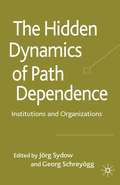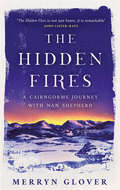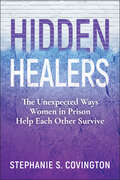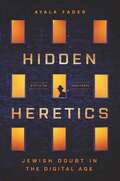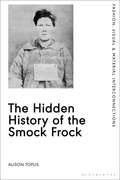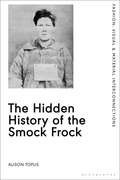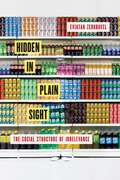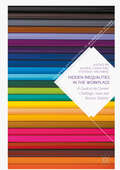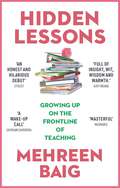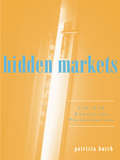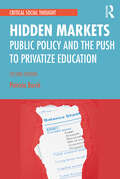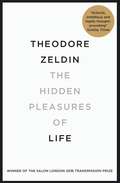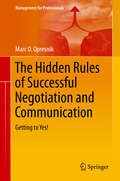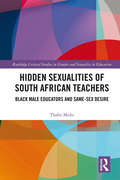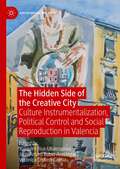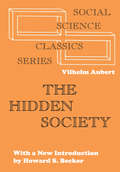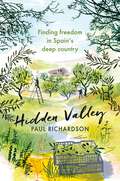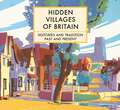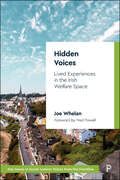- Table View
- List View
The Hidden Dynamics of Path Dependence: Institutions and Organizations
by Georg Schreyögg and Jörg SydowThe theory of path dependence continues to attract great interest in a range of disciplines. An increasing number of scholars have started to explicitly use this theory for studying organizational inertia and institutional rigidities. This volume presents a collection of papers from various international conferences that address these issues.
The Hidden Fires: A Cairngorms Journey with Nan Shepherd
by Merryn Glover'Merryn Glover’s The Hidden Fires is not just brave, it is remarkable' – Sir John Lister-Kaye The Hidden Fires: A Cairngorms Journey with Nan Shepherd is a response to Nan Shepherd’s The Living Mountain. Drawing from the author's upbringing in the Himalayas and gradual adaptation to Scotland’s hills, Merryn Glover contrasts her own Cairngorm experiences with Shepherd’s. Exploring the same landscapes and themes of the classic work, she challenges the reader to new understandings of this mountain range and its significance in contemporary Scotland.
Hidden Healers: The Unexpected Ways Women in Prison Help Each Other Survive
by Stephanie S. CovingtonA gripping and deeply-felt examination of incarcerated women's lives With unflinching clarity, Hidden Healers cuts through the myths about incarcerated women to expose the all-too-real brutalities they face within a criminal legal system never designed for them. Backed by three decades' experience providing therapeutic programs inside prisons across the United States, trauma specialist Dr. Stephanie Covington has used her unique access to amplify the voices of the women themselves. Their stories illuminate realities most never see: that most women who get caught up in the criminal justice system have themselves been victims of harm, that the degradations of today's prisons and jails only magnify their trauma- and that incarcerated women regularly risk punishment to tend to one another's well-being in unexpected acts of kindness. Grounded in research and rich with personal narrative, Hidden Healers is a poignant and riveting look inside women's prisons and jails- and what we can do to help.
Hidden Healers: The Unexpected Ways Women in Prison Help Each Other Survive
by Stephanie S. CovingtonA gripping and deeply-felt examination of incarcerated women's lives With unflinching clarity, Hidden Healers cuts through the myths about incarcerated women to expose the all-too-real brutalities they face within a criminal legal system never designed for them. Backed by three decades' experience providing therapeutic programs inside prisons across the United States, trauma specialist Dr. Stephanie Covington has used her unique access to amplify the voices of the women themselves. Their stories illuminate realities most never see: that most women who get caught up in the criminal justice system have themselves been victims of harm, that the degradations of today's prisons and jails only magnify their trauma- and that incarcerated women regularly risk punishment to tend to one another's well-being in unexpected acts of kindness. Grounded in research and rich with personal narrative, Hidden Healers is a poignant and riveting look inside women's prisons and jails- and what we can do to help.
Hidden Heretics: Jewish Doubt in the Digital Age (Princeton Studies in Culture and Technology #27)
by Ayala FaderA revealing look at Jewish men and women who secretly explore the outside world, in person and online, while remaining in their ultra-Orthodox religious communities What would you do if you questioned your religious faith, but revealing that would cause you to lose your family and the only way of life you had ever known? Hidden Heretics tells the fascinating, often heart-wrenching stories of married ultra-Orthodox Jewish men and women in twenty-first-century New York who lead “double lives” in order to protect those they love. While they no longer believe that God gave the Torah to Jews at Mount Sinai, these hidden heretics continue to live in their families and religious communities, even as they surreptitiously break Jewish commandments and explore forbidden secular worlds in person and online. Drawing on five years of fieldwork with those living double lives and the rabbis, life coaches, and religious therapists who minister to, advise, and sometimes excommunicate them, Ayala Fader investigates religious doubt and social change in the digital age.The internet, which some ultra-Orthodox rabbis call more threatening than the Holocaust, offers new possibilities for the age-old problem of religious uncertainty. Fader shows how digital media has become a lightning rod for contemporary struggles over authority and truth. She reveals the stresses and strains that hidden heretics experience, including the difficulties their choices pose for their wives, husbands, children, and, sometimes, lovers. In following those living double lives, who range from the religiously observant but open-minded on one end to atheists on the other, Fader delves into universal quandaries of faith and skepticism, the ways digital media can change us, and family frictions that arise when a person radically transforms who they are and what they believe.In stories of conflicts between faith and self-fulfillment, Hidden Heretics explores the moral compromises and divided loyalties of individuals facing life-altering crossroads.
The Hidden History of the Smock Frock (Fashion: Visual & Material Interconnections)
by Alison ToplisTraditionally associated with rural ways of life in England, often hand-crafted and held up as one of the only items of English folk dress to survive into the 20th century, the smock frock is an object of curiosity in many museum collections. Drawing on a wide variety of sources from surviving garments to newspapers and photographs, this book reveals the hidden history of the smock frock to present new social histories.Discussing the smock frock in its widest contexts, Alison Toplis explores how garments were handmade and manufactured by the ready-made clothing industry, and bought by men of different trades. She traces the smock frock's usage across England as well as in export markets such as Australia. Following the garment's decline in the late 19th century, the book investigates how this essentially utilitarian style of workwear came to be held up as an example of disappearing 'peasant' craft in an emotional response to urbanisation, and how it was preserved by collectors under the influence of the Arts and Crafts movement.Around the turn of the 20th century, the smock frock was reinvented as both women's and children's wear and is now regularly revived in fashion collections by the likes of Molly Goddard. Drawing together extensive visual and material cultures, Alison Toplis unravels a new history of the smock frock.
The Hidden History of the Smock Frock (Fashion: Visual & Material Interconnections)
by Alison ToplisTraditionally associated with rural ways of life in England, often hand-crafted and held up as one of the only items of English folk dress to survive into the 20th century, the smock frock is an object of curiosity in many museum collections. Drawing on a wide variety of sources from surviving garments to newspapers and photographs, this book reveals the hidden history of the smock frock to present new social histories.Discussing the smock frock in its widest contexts, Alison Toplis explores how garments were handmade and manufactured by the ready-made clothing industry, and bought by men of different trades. She traces the smock frock's usage across England as well as in export markets such as Australia. Following the garment's decline in the late 19th century, the book investigates how this essentially utilitarian style of workwear came to be held up as an example of disappearing 'peasant' craft in an emotional response to urbanisation, and how it was preserved by collectors under the influence of the Arts and Crafts movement.Around the turn of the 20th century, the smock frock was reinvented as both women's and children's wear and is now regularly revived in fashion collections by the likes of Molly Goddard. Drawing together extensive visual and material cultures, Alison Toplis unravels a new history of the smock frock.
Hidden in Plain Sight: The Social Structure of Irrelevance
by Eviatar ZerubavelMany of us take for granted that what we perceive is a completely accurate representation of the world around us. Yet we have all had the experience of suddenly realizing that the keys or glasses that we had been looking for in vain were right in front of us the whole time. The capacity of our sense organs far exceeds our mental capabilities, and as such, looking at something does not guarantee that we will notice it. Our minds constantly prioritize and organize the information we take in, bringing certain things to the foreground, while letting others - that which we deem irrelevant - recede into the background. What ultimately determines what we perceive, and what we do not? In this fascinating book, noted sociologist Eviatar Zerubavel argues that we perceive things not just as human beings but as social beings. Drawing on fascinating examples from science, the art world, optical illusions, and all walks of life, he shows that what we notice or ignore varies across cultures and throughout history, and illustrates how our environment and our social lives - everything from our lifestyles to our professions to our nationalities - play a role in determining how we actually use our senses to access the world. A subtle yet powerful examination of one of the central features of our conscious life, this book offers a way to think about all that might otherwise remain hidden in plain sight.
Hidden in Plain Sight: The Social Structure of Irrelevance
by Eviatar ZerubavelMany of us take for granted that what we perceive is a completely accurate representation of the world around us. Yet we have all had the experience of suddenly realizing that the keys or glasses that we had been looking for in vain were right in front of us the whole time. The capacity of our sense organs far exceeds our mental capabilities, and as such, looking at something does not guarantee that we will notice it. Our minds constantly prioritize and organize the information we take in, bringing certain things to the foreground, while letting others - that which we deem irrelevant - recede into the background. What ultimately determines what we perceive, and what we do not? In this fascinating book, noted sociologist Eviatar Zerubavel argues that we perceive things not just as human beings but as social beings. Drawing on fascinating examples from science, the art world, optical illusions, and all walks of life, he shows that what we notice or ignore varies across cultures and throughout history, and illustrates how our environment and our social lives - everything from our lifestyles to our professions to our nationalities - play a role in determining how we actually use our senses to access the world. A subtle yet powerful examination of one of the central features of our conscious life, this book offers a way to think about all that might otherwise remain hidden in plain sight.
Hidden Inequalities in the Workplace: A Guide to the Current Challenges, Issues and Business Solutions (Palgrave Explorations in Workplace Stigma)
by Valerie Caven and Stefanos NachmiasThe book presents a critical framework for assessing whether organisational practice and function reinforces unseen potential differences amongst individuals in the workplace. It offers a comprehensive understanding and awareness of managerial and organisational practices that perpetuate social exclusion and discrimination towards individuals in the workplace. The book draws together themes of non-declared medical or physical conditions, voluntary and involuntary disclosure of difference, dietary requirements, lifestyle, organisational engagement and cognitive bias. As a result, the book provides a unique blend of scholarly and professional research, and brings those who have been affected by social stigmas and discrimination in the workplace to the fore. Hidden Inequalities in the Workplace also offers practical and strategic insights for practitioners, students and policy-makers, and delves the strategic nature of policy intervention and thought-provoking dialogue
Hidden Lessons: Growing Up on the Frontline of Teaching
by Mehreen Baig'Beautifully written, Hidden Lessons is both a heart-rending account of the challenges in our education system, and a heart-warming celebration of teachers and students who have triumphed through adversity. The pride Mehreen has for her community and the lives she has touched is palpable.' - DAVID LAMMY~~~~~~~~~~~~You're in at 7am, there until 7pm and marking into the late hours. You've got one student who's a full time carer, another who's pregnant, and a third who's just joined a gang. You haven't got enough textbooks to go around, and one of the parents just called you an 'extremist'. You've just gone through a devastating heartbreak and you have to teach Romeo and Juliet to 30 hormonal 14 year olds.Welcome to life as a teacher.This is a world that all of us know, but most of us have completely forgotten. It's a world where you're working 50 hour weeks, but you're still just a part-time teacher because the rest of the time you're a security guard, a nurse, a counsellor, or a friend. It's also a world where you spend all day with some of the most interesting people you know. And even when the lesson plan has been abandoned, you're still learning.Mehreen started teaching at 21, and by the time she left 10 years later she'd learnt a bit about teenagers and a lot about life. This is her story.
Hidden Markets: The New Education Privatization (Critical Social Thought)
by Patricia BurchAcross the U.S., test publishers, software companies, and research firms are swarming to take advantage of the revenues made available by the No Child Left Behind Act. In effect, the education industry has assumed a central place in the day-to-day governance and administration of public schools—a trend that has gone largely unnoticed by policymakers or the press until now. Drawing on analytic tools, Hidden Markets examines specific domains that the education industry has had particular influence on—home schooling, remedial instruction, management consulting, test development, data management, and staff development. Burch's analysis demonstrates that only when we subject the education industry to systematic and in-depth critical analysis can we begin to demand more corporate accountability and organize to halt the slide of education funds into the market.
Hidden Markets: The New Education Privatization (Critical Social Thought)
by Patricia BurchAcross the U.S., test publishers, software companies, and research firms are swarming to take advantage of the revenues made available by the No Child Left Behind Act. In effect, the education industry has assumed a central place in the day-to-day governance and administration of public schools—a trend that has gone largely unnoticed by policymakers or the press until now. Drawing on analytic tools, Hidden Markets examines specific domains that the education industry has had particular influence on—home schooling, remedial instruction, management consulting, test development, data management, and staff development. Burch's analysis demonstrates that only when we subject the education industry to systematic and in-depth critical analysis can we begin to demand more corporate accountability and organize to halt the slide of education funds into the market.
Hidden Markets: Public Policy and the Push to Privatize Education (Critical Social Thought)
by Patricia BurchAcross the United States, test publishers, software companies, and research firms continue to take advantage of the revenues made available by federal policies like the No Child Left Behind Act, Race to the Top, and the Elementary and Secondary Education Act. In effect, the education industry has assumed a central place in the day-to-day governance and administration of public schools—a previously hidden trend that has begun to be a ubiquitous component of public education. Drawing on analytic tools, Hidden Markets examines specific domains that the education industry has had particular influence on—home schooling, remedial instruction, management consulting, test development, data management, and staff development. With updated and new material added, this second edition also highlights how technology and technology policy shape the conditions for teachers’ work, the role of natural disasters as education market opportunities, and the connection between racism and educational privatization. Burch's analysis demonstrates that only when we subject the education industry to systematic and in-depth critical analysis can we begin to demand more corporate accountability and organize to halt the slide of education funds into the market. Additional updates include: Discussion of the role that policy elites play in allowing CEOS to regulate the student identity market Examination of the rise of online tutoring engineered in part by the No Child Left Behind Act New chapter that offers an updated road map for policymakers and activists concerned about the issues raised within the book
Hidden Markets: Public Policy and the Push to Privatize Education (Critical Social Thought)
by Patricia BurchAcross the United States, test publishers, software companies, and research firms continue to take advantage of the revenues made available by federal policies like the No Child Left Behind Act, Race to the Top, and the Elementary and Secondary Education Act. In effect, the education industry has assumed a central place in the day-to-day governance and administration of public schools—a previously hidden trend that has begun to be a ubiquitous component of public education. Drawing on analytic tools, Hidden Markets examines specific domains that the education industry has had particular influence on—home schooling, remedial instruction, management consulting, test development, data management, and staff development. With updated and new material added, this second edition also highlights how technology and technology policy shape the conditions for teachers’ work, the role of natural disasters as education market opportunities, and the connection between racism and educational privatization. Burch's analysis demonstrates that only when we subject the education industry to systematic and in-depth critical analysis can we begin to demand more corporate accountability and organize to halt the slide of education funds into the market. Additional updates include: Discussion of the role that policy elites play in allowing CEOS to regulate the student identity market Examination of the rise of online tutoring engineered in part by the No Child Left Behind Act New chapter that offers an updated road map for policymakers and activists concerned about the issues raised within the book
The Hidden Pleasures of Life: A New Way of Remembering the Past and Imagining the Future
by Theodore ZeldinThe story of a search for a new art of living. How can one escape from work colleagues who are bores and from organisations that thrive on stress? What new priorities can people give to their private lives? When the romantic ideal is disappointing, how else can affections be cultivated? If only a few can become rich, what substitute is there for dropping out? If religions and nations disagree, what other outcomes are possible beyond strife or doubt? Where there is too little freedom, what is the alternative to rebellion? When so much is unpredictable, what can replace ambition? Questions include: What is the great adventure of our time? What is a wasted life? How can people lose their illusions about themselves? What alternatives are there to being a rebel? What can the poor tell the rich? What could the rich tell the poor? How many ways of committing suicide are there? How can an unbeliever understand a believer? How can a religion change? How can prejudices be overcome? How can one think about the future, without trying to predict it or worrying about it? Is ridicule the most effective form of non-violent protest? How does one acquire a sense of humour? What stops people feeling completely at home in their own country? How many nations can one love at the same time? Why do so many people feel unappreciated, unloved and not fully alive? How else might women and men treat one another? What can replace the shortage of soul-mates? Is another kind of sexual revolution achievable? What can artists aim for beyond self-expression? What is more interesting than becoming a leader? What is the point of working so hard? Are there more amusing ways of earning a living? What else can one do in a hotel? What more can the young ask of their elders? Is remaining young at heart enough to avoid becoming old? What is worth knowing? What does it mean to be alive? Where can one find nourishment for the mind?
The Hidden Rules of Successful Negotiation and Communication: Getting to Yes! (Management for Professionals)
by Marc O. OpresnikNegotiations in professional or private life often take an unsatisfactory course due to stress, confrontation with aggressive or unfair behavior, or because of overwhelming situations.Negotiations generally require a thorough preparation, strategy and a sophisticated tactic to make us feel safe in the presentation of our goals and arrive at a mutually satisfactory outcome. Conventional books about negotiations are usually limited to strategies and techniques, but leave out elements of psychological communication and emotional intelligence, which include non-verbal communication and empathy, which in turn are essential for successful negotiation. Therefore, this book on the one hand constitutes the essential techniques and strategies in the context of negotiation, but also considers "soft skills" without which negotiations cannot be successful.This book presents practical examples in dealing with situations such as salary, contract and sales negotiations. In particular on context and time appropriate negotiation techniques; analyzing negotiation partners and their motives; interpret group processes, and how to successfully implement negotiation psychology.
Hidden Sexualities of South African Teachers: Black Male Educators and Same-sex Desire (Routledge Critical Studies in Gender and Sexuality in Education)
by Thabo MsibiSouth Africa remains a global leader in the legislative protection of individuals who engage in same-sex relations, and is the only country in Africa where the rights of these individuals are explicitly recognized and protected by the constitution. Yet South Africa’s identities are still contested and evolving, particularly for same-sex desiring teachers – many are forced to locate their sexualities privately for fear of being ostracized, bullied or losing their jobs, resulting in the miseducation of young people in schools. This volume reveals the various ways in which black South African male teachers construct their sexual and professional identities, how they accommodate structural dictates while simultaneously resisting them, and the effect this has on students. Presenting the day-to-day experiences of eight same-sex desiring teachers within repressive contexts, this volume challenges the Western origins and assumptions of queer theory, particularly its inability to confront communal forms of social organizing and its focus on individual agency. It asks for more socially responsive theorizing that takes into account the role played by location, race, class, gender and sexual identification within South African and international contexts.
Hidden Sexualities of South African Teachers: Black Male Educators and Same-sex Desire (Routledge Critical Studies in Gender and Sexuality in Education)
by Thabo MsibiSouth Africa remains a global leader in the legislative protection of individuals who engage in same-sex relations, and is the only country in Africa where the rights of these individuals are explicitly recognized and protected by the constitution. Yet South Africa’s identities are still contested and evolving, particularly for same-sex desiring teachers – many are forced to locate their sexualities privately for fear of being ostracized, bullied or losing their jobs, resulting in the miseducation of young people in schools. This volume reveals the various ways in which black South African male teachers construct their sexual and professional identities, how they accommodate structural dictates while simultaneously resisting them, and the effect this has on students. Presenting the day-to-day experiences of eight same-sex desiring teachers within repressive contexts, this volume challenges the Western origins and assumptions of queer theory, particularly its inability to confront communal forms of social organizing and its focus on individual agency. It asks for more socially responsive theorizing that takes into account the role played by location, race, class, gender and sexual identification within South African and international contexts.
The Hidden Side of the Creative City: Culture Instrumentalization, Political Control and Social Reproduction in Valencia (Sociology of the Arts)
by Joaquim Rius-Ulldemolins Juan Arturo Rubio-Arostegui Verònica Gisbert-GraciaThis book analyses issues related to the political use and economical misappropriation of urban cultural events, cultural infrastructures, public resources, and cultural traditions in the city of Valencia, Spain. It deals critically with a variety of sociological questions related to cultural production in the city, including geographical segregation as culturally defined in the city; misogyny and the peripheral role of women in traditional cultural events, xenophobia; and nationalism/regionalism.As such, the book will be useful to students and scholars of sociology of the arts, cultural policy, and museum management, and urban sociology.
The Hidden Society (Social Science Classics Ser.)
by J. E. MeadeSocieties consider certain institutions and activities as central, proper, and visible, while others are defined as peripheral, deviant, and private. Vilhelm Aubert takes us to the ""hidden"" societies: the privacy of love, the secrecy of the underground, the remoteness of a ship, the isolation of the ill, the retirement from social life into sleep, and similar fascinating topics.Vilhelm Aubert, a professor of sociology in the Law Faculty of Oslo University and a member of the board of directors of Oslo's famed Institute of Social Research, presents a theory of the hidden societies, a theory concerned with concepts such as time and space, causality, will, and' chance. Chapters on predictability and chance deal with lack of 6rder, with phenomena that appear meaningless or absurd from a point of view very prevalent in modern life. We are presented with a study of isolation as a sociological phenomenon - accepted or fostered by social action - and we see how the existence of lonely, private niches in a society serves, consciously or unconsciously, to satisfy-idiosyncratic needs of individual personalities.
The Hidden Society
by J. E. MeadeSocieties consider certain institutions and activities as central, proper, and visible, while others are defined as peripheral, deviant, and private. Vilhelm Aubert takes us to the ""hidden"" societies: the privacy of love, the secrecy of the underground, the remoteness of a ship, the isolation of the ill, the retirement from social life into sleep, and similar fascinating topics.Vilhelm Aubert, a professor of sociology in the Law Faculty of Oslo University and a member of the board of directors of Oslo's famed Institute of Social Research, presents a theory of the hidden societies, a theory concerned with concepts such as time and space, causality, will, and' chance. Chapters on predictability and chance deal with lack of 6rder, with phenomena that appear meaningless or absurd from a point of view very prevalent in modern life. We are presented with a study of isolation as a sociological phenomenon - accepted or fostered by social action - and we see how the existence of lonely, private niches in a society serves, consciously or unconsciously, to satisfy-idiosyncratic needs of individual personalities.
Hidden Valley: Finding freedom in Spain's deep country
by Paul RichardsonThe story of the real 'good life' of an off-grid existence in rural SpainPaul Richardson fled the city to live on the land in a rough-and-tumble village on the edge of Europe. Immersing himself in the culture of his remote Spanish community, he learned the traditional arts of animal husbandry and vegetable growing, wine-making and home distilling, and made bread from the rye he sowed on the stone-walled terraces of his twelve-acre farm. In prose that shimmers with wit and sensuality, the author charts his personal route-map along a road less travelled - from urban pressures to rural tranquility, and from insecurity to fulfilment. Along the way he pays tribute to the influences that have shaped his progress - from The Good Life to Henry David Thoreau, from the 1970s pioneers to self-sufficiency to his farming neighbours in the far-flung region of Extremadura. In Richardson's hands, off-grid living both becomes an act of rebellion and a heartening proof that a simpler, better life is possible, if only we can remove ourselves from the ethos in which conspicuous consumption is a duty and success/failure the wheel on which society turns. Hidden Valley is a glorious narrative of one man's journey towards self-reliance. Original and thought-provoking, it is also hugely entertaining.
Hidden Voices: Lived Experiences in the Irish Welfare Space (Key Issues in Social Justice)
by Joe WhelanUnderpinned by the idea of the right to a ‘basic minimum’, welfare states are a major feature of many societies. However, the lived experiences of persons seeking and receiving welfare payments can often be overlooked. This book seeks to remedy this omission by honouring lived experience as valuable, insightful and necessary. It draws on qualitative interviews with 19 people receiving various working age welfare payments in Ireland to explore stigma, social reciprocity and the notions of the deserving and undeserving poor, and to analyse welfare conditionality in the Irish context. Breaking new ground, this book offers original research findings which contest and inform policy both within Ireland and beyond.
